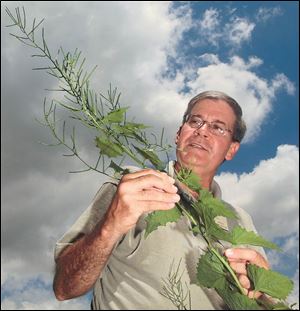
Don't let invaders gain a foothold in your backyard
6/20/2001They might be beautiful, but some wild weeds can get out of hand. If these botanical invaders aren't removed from our park areas and backyards, they can choke out more desirable plants.
Jennifer Windus, research and monitoring administrator for the Ohio Department of Natural Resources, teaches people across the state about the problems that invasive weeds can cause.
Over the last three years, ODNR has closely examined the impact that some plants are making on our natural areas. Many non-native species are creeping in and pushing out the native wildflowers and other plants.

John Jaeger, Toledo Area Metroparks natural resources manager, displays garlic mustard, an aggressive invasive plant that grows in woodland settings, at Secor Metropark.
“About 25 percent of the 3,000 species of wildflowers in Ohio are non-native,” says Ms. Windus. “Some of those non-native invasive species are what we are most concerned with.
“I would guess that at least over a half million dollars is spent per year by land management agencies to get rid of these noxious weeds,” she says.
OHIO INVADERS
Garlic mustard, Japanese honeysuckle, and autumn olive are three aggressive invaders that need to be removed from area parks each year.
John Jaeger, Toledo Area Metroparks natural resources manager, says garlic mustard grows in woodland settings, honeysuckle is found in wetlands, and autumn olive thrives in meadow areas.
Buckthorns, reed canary grass, common reed grass, purple loosestrife, multifloral rose, and Japanese knotweed are also common non-native invaders.
Garlic mustard (Alliaria petiolata) will grow about four feet tall and has small white flowers with four petals that grow in clusters at the top. The foliage has a kidney or heart-shaped leaf with jagged edges and smells like garlic. According to the ODNR, it is a biennial herb. It grows its foliage the first year, then overwinters to grow taller, flower, and set seed the second year.
Honeysuckle is usually a gardener's favorite quick-growing vine. It is extremely fragrant, and if it is Japanese honeysuckle, (Lonicera japonica) it just takes over your backyard.
“You can spot Japanese honeysuckle by its foliage,” says Mr. Jaeger. “It keeps its leaves late in the season and is the first to leaf out in the summer.”
It has the same yellow and white flowers like other types of honeysuckle, with a woody semi-evergreen stem. According to ODNR, its flowers grow in pairs and form purple and black berries. It will usually grow over native vegetation like a big green curtain.
Autumn olive (Eleaegnus umbellata) can grow to be a 20-foot tree if it gets out of control. It starts out as a fast-growing shrub. Its small dark green leaves are silver underneath. If you look closely, you can see small copper-colored dots on the stems and leaves. Birds and bees like its red fruits and light yellow flowers.
REMOVING THE INVADERS
Experienced professionals may try burning the noxious weeds to remove them. Homeowners should try pulling them out by hand or using a systemic herbicide. Be sure to remove all of the root that you can and dispose of them where they can be burned. Don't put them in the compost pile.
Since these invaders have learned to grow in any type of condition, they are tough to eradicate. You may need to continually pull or spray the weeds all summer long.
Before digging up a beautiful vine, plant, or shrub from the wild, be sure you know what you are digging. Noxious weeds such as purple loosetrife trick you with their beauty. Once you dig them up and plant them in your yard, you may never get rid of them.
PICKING NEW PLANTS
“When you take something out of the landscape, you need to replace it with something else,” says Mr. Jaeger. “If you don't, that same invasive plant or other one will come in and fill the open space.”
Once you get the garlic mustard cleared out, ODNR recommends replacing it with white baneberry (Actaea pachypoda), wild columbine (Aquilegia canadensis), blue phlox (Phlox divaricata), or black cohosh (Cimicifuga racemosa.).
Virginia creeper (Parthenocissus quinquefolia), wild honeysuckle (Lonicera dioica) and virgin's bower (Clematis virginiana) are native alternatives for Japanese honeysuckle recommended by ODNR.
Autumn olive can be replaced with black haw (Viburnum prunifolium), dogwoods (Cornus racemosa, C. amomum), paw-paw (Asimina triloba), and spicebush (Lindera benzoin).
“Wildlife feeds on the seeds and berries of some of these invasive weeds, so we need to replenish their food supply,” says Mr. Jaeger.
Brochures and fact sheets are available by contacting the Ohio Department of Natural Resources at (614) 265-6453 or the Nature Conservancy at (614) 717-2770.
Kelly Heidbreder is The Blade's garden writer. E-mail her at getgrowingkelly@aol.com.